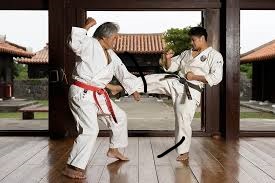
Ageuke (上げ受け): A vertical block applied against opponent’s attacks on high areas of the body or limbs.
Gedanbarai (下段払い): A move that can be used to parry low hits from punches or kicks.
Sotouke (外受け): A structure on the outside that is used to deflect the incoming attacks.
Kicks (蹴り Geri):
Maegeri (前蹴り): A technique of kicking with the ball of the foot or with the heel, which is used as the first step in approaching the opponent.
Yokogeri (横蹴り): A kick, which is one of the most effective techniques and is characterized by not only the distance.
Mawashigeri (回し蹴り): A rotating kick that is used to strike the ribs, head or the legs.
These basic techniques are rehearsed over and over in order that they can be operated proficiently in training and real life scenarios.
Advanced Techniques
From here, the professional graduates to intermediate level where they perform techniques that involve speed, power, and staking. These techniques are applied in the techniques of sparring (kumite) and defended self:
- Combination Techniques:
Renzuki (連突き): A series of quick blows which are thrown in order to weaken the opponent before the onset of the actual fight.
Kizamizuki + Gyakuzuki: A left hook followed by a right hook, making the punch looks very effective and fast.
- Throws and Sweeps:
Ashibarai (足払い): A sweep that targets the feet of an opponent with an aim of throwing her off balance.
Koshiwaza (腰技): Some of the hip throws that have been borrowed from Judo that are often used when fighting in close quarters include.
- Counterattacks:
Ukezuki (受け突き): A combination of a block and an attack in which a block is performed right after a punch.
Gyakuzuki: It translates to a knee strike and is followed by the Hizageri which is a reverse punch effective when the opponent is close.
- Advanced Kicks:
Ushirogeri (後ろ蹴り): A spinning back kick, driving a great amount of energy into the target of the adversary.
Tobigeri (飛び蹴り): A jumping kick mainly employed for range decrease and targeting the upper part of the body.
Situational strategies presented in this paper are not only physical but also demand mental and timing skills. They are mostly performed by dummy fights, drills and sparring to mimic the actual fighting.
Weapon Techniques (Kobudo)
While karate is considered an art of empty hand, Kobudo is a martial art of Okinawan weapons. These weapons were actually farming tools that were used in defense when the use of weapons was prohibited in Okinawa. Kobudo weapons are not as numerous as those of other martial arts, but there are several of them and some of the most widely known include the following:
- Bo (棒): A weapon about 6 feet in length which is used in hitting, parrying as well as thrusting.
- Sai (釵): It is a three-pronged and metallic weapon, which is primarily employed for warding off an opponent’s weapon and trapping it.
- Nunchaku (ヌンチャク): Two pieces of wood connected with a piece of chain or rope, it is a fast weapon.
- Tonfa (トンファー): A wooden baton with a handle, used for striking and blocking.
Kobudo is a good addition to the training of karate since it improves coordination, strength, and knowledge of weapons fighting. Most karate schools include Kobudo as one of the martial arts practiced in the school as a beginner martial art.
The techniques used in Karate are a combination of strength and accuracy and are very much effective. Starting from stances and movements to creative combinations and armory each of the technique has its unique use in training and defense. Through these techniques, the practitioners can build up the most essential skills and confidence to be used in the aspects of karate. These techniques are some of the best practices that any single martial artist will need when practicing in the dojo or participating in tournament.